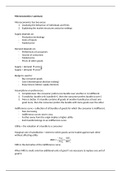Samenvatting
Summary Microeconomics I Economics and Business Economics Vrije Universiteit, ISBN: 9781319153960 Microeconomics I (E_EBE1_MICEC)
- Instelling
- Vrije Universiteit Amsterdam (VU)
- Boek
- Microeconomics
Summary of Microeconomics I, a first year course of Economics and Business Economics at the VU. I got an 8 by learning this (and of course making the math exercises) so I think it is a good summary to learn for your Micro test!
[Meer zien]





